On 26th June 1951, a tablet naming 27 civil servants who had died on active service during the Second World War was unveiled in Parliament Building by Lieutenant-General Sir Reginald Denning, GOC for the Northern Ireland District. The memorial is built into the fabric of the building just inside the main entrance. The memorial does not commemorate civil servants who died in the German air raids.
This article contains basic details about each fatality named on the memorial and further details on any individual can be obtained from History Hub Ulster upon request.
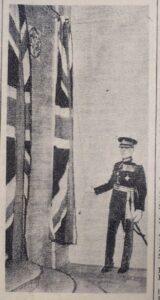
Ministry of Agriculture
Sergeant Eric Ritchie Bowman (Number 1500548, Royal Air Force Volunteer Reserve) was serving with 26 Conversion Flight when he was Killed in Action on 24th December 1941, aged 25, and is buried in Bangor Cemetery.
Flight Lieutenant David Mark Campbell (Number 12041, Royal Air Force Volunteer Reserve) was serving with 107 Squadron when he died in an aircraft crash on 17th March 1944, aged 31, and is buried in Clondevaddock (Christ the Redeemer) Church of Ireland Graveyard in County Donegal.
Sergeant Nathaniel Hugh Crawford (Number 1545675, Royal Air Force Volunteer Reserve) was serving with 1654 Heavy Conversion Unit when he died in an aircraft crash on 31st May 1944, aged 30, and is buried in Raloo Parish Church Graveyard in County Antrim.
Captain Archibald MacDougall Fyfe (Number 260202, Royal Army Veterinary Corps) was a Veterinary Inspector in civilian life and was serving with 77th Indian Brigade (Orde Wingate’s “Chindits”) when he was Killed in Action on 13th July 1944, aged 31, and is commemorated on the Rangoon Memorial in Myanmar.
Captain Robert Stewart Hall (Number 177406) was commissioned with the Royal Artillery but was serving with 2nd Battalion Royal Ulster Rifles when he was Killed in Action on 9th June 1944, aged 26, and is buried in the Cambes-en-Plaine War Cemetery in France.
 Sergeant John Johnston Simpson (Number 1045724, Royal Air Force Volunteer Reserve) was serving with 12 Squadron when he was Killed in Action on 15th June 1943, aged 26, and is buried in the Rheinberg War Cemetery in Germany.
Sergeant John Johnston Simpson (Number 1045724, Royal Air Force Volunteer Reserve) was serving with 12 Squadron when he was Killed in Action on 15th June 1943, aged 26, and is buried in the Rheinberg War Cemetery in Germany.
Sergeant Victor Hall Skillen (Number 745460, Royal Air Force Volunteer Reserve) was serving with 23 Squadron when he died in an aircraft crash on 11th March 1941, aged 24, and is buried in the St. Pierre Cemetery at Amiens in France
Ordnance Survey of Northern Ireland
Flying Officer Andrew Alexander Henry (Number 131970, Royal Air Force Volunteer Reserve) was serving with 50 Squadron when he was Killed in Action on 10th May 1944, aged 22, and is buried in the Forest-sur-Marque Communal Cemetery in France and commemorated on a family memorial in Forthill Cemetery, Cookstown.
Sergeant Charles Julius Chennell Holland (Number 745631, Royal Air Force Volunteer Reserve) was serving with 107 Squadron when he was Killed in Action on 23rd July 1940, aged 19, and is buried in St Andrew’s Churchyard in Tangmere and commemorated on a family memorial in Bangor Cemetery.
Flying Officer Francis Raymond Moore (Number 60921, Royal Air Force Volunteer Reserve) was serving at Bandung Air Headquarters in Indonesia when he died of illness in a Japanese PoW Camp on 15th July 1943, aged 36, and is buried in the Ambon War Cemetery in Indonesia and commemorated on a family memorial in Bangor Cemetery.
Flight Sergeant Robert Angus Moore (Number 1074933, Royal Air Force Volunteer Reserve) was serving with 297 Squadron when he was Killed in Action on 23rd August 1943, aged 23, and is commemorated on the Runnymede Memorial and on a family memorial in Bangor Cemetery.
Ministry of Labour
(including Labour Exchange, Employment Exchange, Unemployment Assistance Board, Public Assistance Board)

Courtesy of Tommy McClimonds
Bombardier Thomas Wesley Boyd (Number 1542601, Royal Artillery) was serving with 316 Battery (102 Heavy Anti-Aircraft Regiment) when he died of a gastric ulcer in Holywood Military Hospital on 2nd December 1939, aged 48, and is buried in Holywood Cemetery. He had served with the Royal Inniskilling Fusiliers in the Great War and then with the Royal Ulster Constabulary.
Flight Sergeant John Bracken Coffey (Number 1062192, Royal Air Force Volunteer Reserve) was serving with 153 Squadron when he was Killed in Action on 6th April 1945, aged 27, and is commemorated on the Runnymede Memorial.
Chief Yeoman of Signals James Alexander Kane (Number D/J.23704, Royal Navy) was serving on HMS Rawalpindi when he was Killed in Action on 23rd November 1939, aged 42, and is commemorated on the Plymouth Naval Memorial. He had served with the Royal Navy in the Great War.
Sergeant James Douglas Marr (Number 2717958, Irish Guards) was serving with 1st Battalion when he was Killed in Action on 27th April 1943, aged 28, and is buried in the Massicault War Cemetery in Tunisia.
Major John Johnston Waite (Number IA/135, Indian Army) was serving with 9th Jat Regiment when he was Killed in Action on 5th June 1942, aged 47, and is commemorated on the Alamein Memorial in Egypt. He had served with the Royal Irish Rifles and the Indian Army in the Great War and had remained in the Indian Army until 1935.
Ministry of Finance
Flying Officer Arthur Peter Buckley Holmes (Number 90038, Royal Air Force/Auxiliary Air Force) was serving with 502 Squadron when he died in an aircraft crash on 3rd September 1940, aged 32, and is buried in St. Patrick’s Church of Ireland Graveyard, Drumbeg.
Sergeant John Haggan Jeffrey (Number 1062344, Royal Air Force Volunteer Reserve) was serving with 218 Squadron when he died in an aircraft crash on 11th August 1942, aged 20, and is buried in Belfast City Cemetery.
Ministry of Home Affairs
Sergeant John Keatinge Haire (Number 748611, Royal Air Force Volunteer Reserve) and was serving with 145 Squadron when he was Killed in Action on 6th November 1940, aged 20, and is buried in Dundonald Cemetery.
Able Seaman John Raphael Crangle (Number P/UD/X 1399, Royal Navy) had worked at the Royal Courts of Justice and was serving at the HMS Tamar shore base at the Fall of Hong Kong in December 1941. He died at sea as a Japanese Prisoner of War on 2nd October 1942, aged 25, and is commemorated on the Portsmouth Naval Memorial. He is also commemorated on a family memorial in Milltown Roman Catholic Cemetery.
Ministry of Commerce
Flying Officer William Charles Henderson DFC (Number 133044, Royal Air Force Volunteer Reserve) was attached to the Ulster Office in London when he volunteered for war service. He was serving with 108 Squadron when he died in an aircraft crash on 28th December 1943, aged 27, and is buried in the Catania War Cemetery in Sicily.
Other
I have been unable to identify entrance to the Civil Service for Robert James Thompson and William Henry Herbert Howe but there is only one exact match with a Northern Ireland connection for each name. For the other four fatalities in this section, I have identified appointment to the Civil Service but not the ministry for which they worked. Randal Archibald Scott was recorded as working at Stormont in newspaper reports.
Aircraftman 1st Class William Henry Herbert Howe (Number 1902171, Royal Air Force Volunteer Reserve) was serving with the ground crew at RAF Snaith at Goole in Yorkshire when he died of liver cancer at Derby City Hospital on 29th April 1945, aged 50, and is buried in Mullaghdun Church of Ireland Graveyard in County Fermanagh.
Gunner Thomas Stanley Clarke McKee (Number 979660, Royal Artillery) was serving with 5 Field Regiment when he died of illness in a Japanese PoW Camp on 7th August 1945, aged 28, and is buried in the Sai Wan War Cemetery in China.
Sergeant Randal Archibald Scott (Number 981198, Royal Air Force Volunteer Reserve) was serving with 58 Squadron when he was Killed in Action on 27th December 1941, aged 21, and is buried in the Reichwald Forest War Cemetery in Germany.
Fusilier Robert James Thompson (Number 7015620, Royal Inniskilling Fusiliers and formerly Royal Ulster Rifles) was serving with 1st Battalion when he was Killed in Action on 10th January 1943, aged 23, and is commemorated on the Rangoon Memorial in Myanmar.
(It is possible that the man named on the memorial is Robert James Maxwell Thompson, a Great War veteran, who was recorded as being a Messenger in the 1939 Belfast Street Directory. Rifleman Thompson was serving with 6th (Home Defence) Battalion Royal Ulster Rifles (Number D/24542) when he died pancreatic cancer at Stranmillis Military Hospital on 7th January 1942, aged 60, and is buried in Belfast City Cemetery.)
Sergeant William Arthur Thompson (Number 1024879, Royal Air Force Volunteer Reserve) was serving with 12 Squadron when he was Killed in Action on 14th September 1942, aged 25, and is buried in the Rheinberg War Cemetery in Germany and commemorated on a family memorial in Knockbreda Cemetery.
Pilot Officer John David Wright (Number 65591, Royal Air Force Volunteer Reserve) was serving with 7 Squadron when he was Killed in Action on 25th August 1941, aged 24, and is buried in the Rheinberg War Cemetery in Germany.
History Hub Ulster Researcher Nigel Henderson


















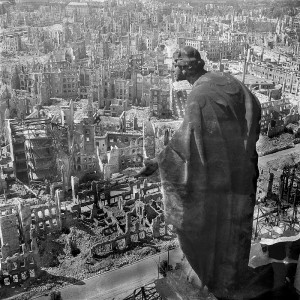 ed States Air Force report defended the operation as the justified bombing of a military and industrial target, which was a major rail transport and communication centre, housing 110 factories and 50,000 workers in support of the German war effort. Several researchers have claimed that not all of the communications infrastructure, such as the bridges, were targeted, nor were the extensive industrial areas outside the city centre.
ed States Air Force report defended the operation as the justified bombing of a military and industrial target, which was a major rail transport and communication centre, housing 110 factories and 50,000 workers in support of the German war effort. Several researchers have claimed that not all of the communications infrastructure, such as the bridges, were targeted, nor were the extensive industrial areas outside the city centre.









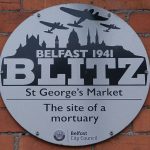 The Commonwealth War Graves Commission (CWGC) website includes a Civilian War Dead section which lists the place of death and the place of residence for fatalities, the information having been collated from the Civil Defence Authority fatality lists and other sources. The anomalies between the figures specified on the Belfast City Council plaques and the CWGC Civilian War Dead List (henceforth CWGC List) will be examined in this article.
The Commonwealth War Graves Commission (CWGC) website includes a Civilian War Dead section which lists the place of death and the place of residence for fatalities, the information having been collated from the Civil Defence Authority fatality lists and other sources. The anomalies between the figures specified on the Belfast City Council plaques and the CWGC Civilian War Dead List (henceforth CWGC List) will be examined in this article.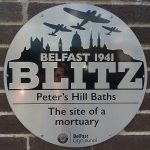 1 Temporary Mortuaries
1 Temporary Mortuaries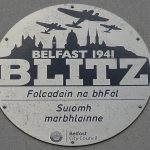
 Campbell College was taken over by the military authorities as the 24th (London) General Hospital shortly after the start of the Second World War and was hit on the night of 4th/5th May 1941. The Blitz Victims List compiled by the Northern Ireland War Memorial records that 24 people died at the hospital, including one civilian fatality. Of the 23 army personnel killed, nine are buried in Northern Ireland and the remainder were repatriated to Great Britain for interment. The civilian was Mary Jane Close (58) who was injured at her home in Westbourne Street and died at the hospital and is buried in Dundonald Cemetery.
Campbell College was taken over by the military authorities as the 24th (London) General Hospital shortly after the start of the Second World War and was hit on the night of 4th/5th May 1941. The Blitz Victims List compiled by the Northern Ireland War Memorial records that 24 people died at the hospital, including one civilian fatality. Of the 23 army personnel killed, nine are buried in Northern Ireland and the remainder were repatriated to Great Britain for interment. The civilian was Mary Jane Close (58) who was injured at her home in Westbourne Street and died at the hospital and is buried in Dundonald Cemetery.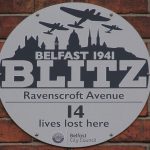
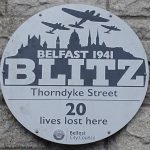 4 Mountpottinger – Thorndyke Street
4 Mountpottinger – Thorndyke Street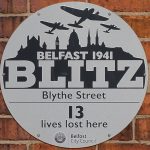 5 Sandy Row – Blythe Street
5 Sandy Row – Blythe Street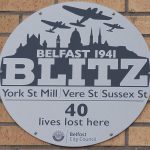
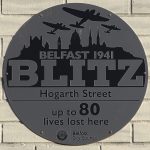 7 Tiger’s Bay – Hogarth Street
7 Tiger’s Bay – Hogarth Street
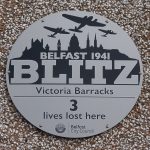
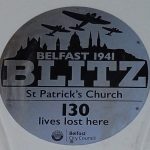 10 Donegall Street – St Patrick’s Church
10 Donegall Street – St Patrick’s Church 11 Carrick Hill – Unity Street and Trinity Street
11 Carrick Hill – Unity Street and Trinity Street
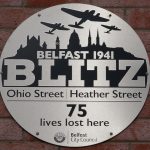
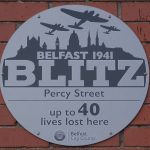
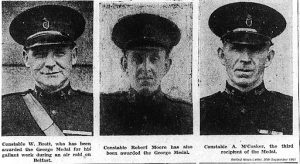
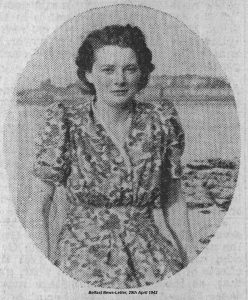 During an air raid in May, Auxiliary Nurse Denise Forster (21) was on duty at the Ambulance Depot on the Holywood Road when it was demolished by a high explosive bomb.
During an air raid in May, Auxiliary Nurse Denise Forster (21) was on duty at the Ambulance Depot on the Holywood Road when it was demolished by a high explosive bomb. 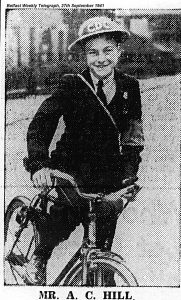 Messenger Alexander Cecil Hill (17), an office assistant from Convention Street, received the BEM. Although severely shaken by an explosion nearby, Alexander directed traffic at a main road whilst bombs were falling nearby. Later, whilst delivering an urgent message to the Report Centre, he was blown off his bicycle by explosions twice but each time he remounted and delivered the message.
Messenger Alexander Cecil Hill (17), an office assistant from Convention Street, received the BEM. Although severely shaken by an explosion nearby, Alexander directed traffic at a main road whilst bombs were falling nearby. Later, whilst delivering an urgent message to the Report Centre, he was blown off his bicycle by explosions twice but each time he remounted and delivered the message. 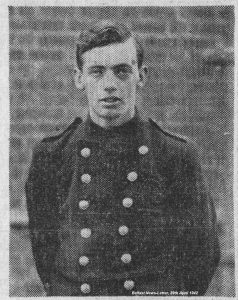 BEMs were awarded to Bomb Identification Officer William John Ford (51) and Messenger William Ernest Bennett (15) of Wandsworth Gardens for rescue work at Cliftonville Road where bombs had destroyed a number of houses and fractured a gas main. Ford and Bennett burrowed six yards through rubble to bring an elderly man to safety and then they rescued two stranded women from a house that was in danger of collapse. Bombs were falling as they worked and both suffered from the effects of inhaling coal gas. William Bennet later joined the National Fire Service.
BEMs were awarded to Bomb Identification Officer William John Ford (51) and Messenger William Ernest Bennett (15) of Wandsworth Gardens for rescue work at Cliftonville Road where bombs had destroyed a number of houses and fractured a gas main. Ford and Bennett burrowed six yards through rubble to bring an elderly man to safety and then they rescued two stranded women from a house that was in danger of collapse. Bombs were falling as they worked and both suffered from the effects of inhaling coal gas. William Bennet later joined the National Fire Service.


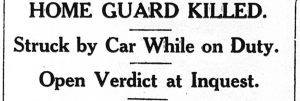 The first fatality on the CWGC list is Special Constable William Mould (Local Defence Volunteer, forerunner of the Ulster Home Guard) of Dunmurry who died at 4:30am on 8th September 1940 when he was struck by a vehicle with no lights when walking home whilst on duty. The car was driven by Lieutenant Ernest John Bloom, Corps of Royal Signals and reports on the inquest were carried by the Lisburn Standard and Lisburn Herald (on 13th and 14th September respectively). William Moulds had served with the Canadian Infantry during the Great War and is commemorated on the War Memorial in Derriaghy Church of Ireland. To date I have been unable to locate the burial location.
The first fatality on the CWGC list is Special Constable William Mould (Local Defence Volunteer, forerunner of the Ulster Home Guard) of Dunmurry who died at 4:30am on 8th September 1940 when he was struck by a vehicle with no lights when walking home whilst on duty. The car was driven by Lieutenant Ernest John Bloom, Corps of Royal Signals and reports on the inquest were carried by the Lisburn Standard and Lisburn Herald (on 13th and 14th September respectively). William Moulds had served with the Canadian Infantry during the Great War and is commemorated on the War Memorial in Derriaghy Church of Ireland. To date I have been unable to locate the burial location.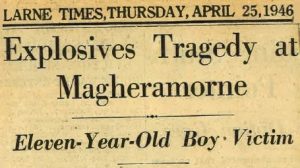
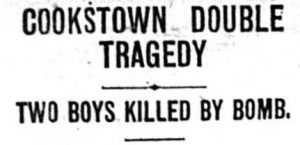
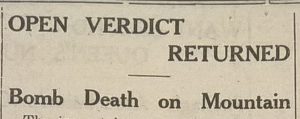
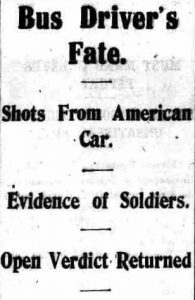 Rodden, accompanied by Frederick McMichael, was returning the bus to the depot in Ballyclare. In giving evidence, Frederick McMichael said that Albert had allowed several vehicles to pass the bus in Main Street, Dungiven before pulling out behind them – there was a further, but different car, behind the bus and the driver of the car sounded the horn and tried to overtake. At Farloe Lane, there was a wide place and Albert pulled in to let the car pass and, as the other car came along at a fast rate, McMichael heard a shot and the bus crashed into a wall. Driver De Felice said that when he tried to pass the bus, the car struck the kerb and his passenger, Sergeant Clipsham swayed with the sudden jerk and appeared to be dumbfounded as if he did not know what had happened. In giving evidence, Sergeant Clipsham reported that he was standing in the car and fell against the machine gun, which started to fire. The funeral at Ballykelly Presbyterian Church was a major affair, including representatives from the “B” Constabulary and the Ulster Home Guard, which would imply that he was providing part-time war service, yet his name is not recorded in the Books of Remembrance for civilian fatalities in the Second World War. The inquest was reported in the Derry Standard and the Derry Journal on 20th April 1942 and in the Londonderry Sentinel on 21st April 1942.
Rodden, accompanied by Frederick McMichael, was returning the bus to the depot in Ballyclare. In giving evidence, Frederick McMichael said that Albert had allowed several vehicles to pass the bus in Main Street, Dungiven before pulling out behind them – there was a further, but different car, behind the bus and the driver of the car sounded the horn and tried to overtake. At Farloe Lane, there was a wide place and Albert pulled in to let the car pass and, as the other car came along at a fast rate, McMichael heard a shot and the bus crashed into a wall. Driver De Felice said that when he tried to pass the bus, the car struck the kerb and his passenger, Sergeant Clipsham swayed with the sudden jerk and appeared to be dumbfounded as if he did not know what had happened. In giving evidence, Sergeant Clipsham reported that he was standing in the car and fell against the machine gun, which started to fire. The funeral at Ballykelly Presbyterian Church was a major affair, including representatives from the “B” Constabulary and the Ulster Home Guard, which would imply that he was providing part-time war service, yet his name is not recorded in the Books of Remembrance for civilian fatalities in the Second World War. The inquest was reported in the Derry Standard and the Derry Journal on 20th April 1942 and in the Londonderry Sentinel on 21st April 1942.
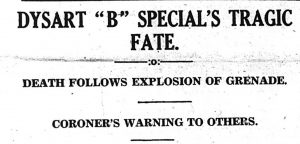 When he was 50 yards from the house, the bomb exploded and Robert John Dodd was taked to Daisy Hill Hospital in Newry, where he later died. The inquest was reported in the Newry Reporter on 30th January 1943.
When he was 50 yards from the house, the bomb exploded and Robert John Dodd was taked to Daisy Hill Hospital in Newry, where he later died. The inquest was reported in the Newry Reporter on 30th January 1943.
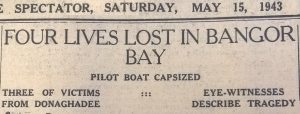 Four North Down men drowned in the incident. Harry Aiken (21), William George Nelson (28, and a crew member of the Donaghadee Lifeboat) and William White (29) from Donaghadee are commemorated on the Donaghadee War Memorial and buried in the Donaghadee Church of Ireland graveyard. The body of William Sloan Anderson (28) from Bangor was washed ashore at Portpatrick in Scotland 38 days after the disaster and he is buried in the Bangor Cemetery and is commemorated on the Bangor War Memorial and on the War Memorial in the Wesley Centenary Methodist Church in Bangor. Although these men lost their lives whilst working under the direction of the Admiralty, they are not recorded as civilian war fatalities on the CWGC database. (additional material provided by Barry Niblock)
Four North Down men drowned in the incident. Harry Aiken (21), William George Nelson (28, and a crew member of the Donaghadee Lifeboat) and William White (29) from Donaghadee are commemorated on the Donaghadee War Memorial and buried in the Donaghadee Church of Ireland graveyard. The body of William Sloan Anderson (28) from Bangor was washed ashore at Portpatrick in Scotland 38 days after the disaster and he is buried in the Bangor Cemetery and is commemorated on the Bangor War Memorial and on the War Memorial in the Wesley Centenary Methodist Church in Bangor. Although these men lost their lives whilst working under the direction of the Admiralty, they are not recorded as civilian war fatalities on the CWGC database. (additional material provided by Barry Niblock)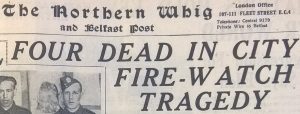 Messrs Redmond, Sons & Company, a manufacturer of packing cases, employed a night-watchman and fire-watchers at its premises on the corner of Connaught Street and Milner Street in the Village district of South Belfast. When William Elliott arrived at the works at 7:30am on the morning of 2nd December 1942, he found the night-watchman, Alexander Watson of Coolderry Street, lying on the floor in front of a gas fire and later found the four fire-watchers in their beds – two men, William Dowling of Donegall Avenue and James Campbell of Norfolk Drive, were already dead and the other two men were taken to the near-by Royal Victoria Hospital. George Leslie of Olympic Drive died in hospital but Henry Kavanagh (18) of Ross Street survived. The gas fire and the radiator in the sleeping quarters had been installed only ten days previously and, whilst William Elliott reported that he had noticed a strong smell of gas, a Corporation expert examined the radiator and reported that it was in perfect order and that there was no sign of an escape of gas. James Campbell (18) was buried in Milltown Roman Catholic Cemetery, William John Dowling (49) was buried in Dundonald Cemetery, George Leslie (37) was buried in Belfast City Cemetery and Alexander Watson (63) was buried in Lurgan Cemetery.
Messrs Redmond, Sons & Company, a manufacturer of packing cases, employed a night-watchman and fire-watchers at its premises on the corner of Connaught Street and Milner Street in the Village district of South Belfast. When William Elliott arrived at the works at 7:30am on the morning of 2nd December 1942, he found the night-watchman, Alexander Watson of Coolderry Street, lying on the floor in front of a gas fire and later found the four fire-watchers in their beds – two men, William Dowling of Donegall Avenue and James Campbell of Norfolk Drive, were already dead and the other two men were taken to the near-by Royal Victoria Hospital. George Leslie of Olympic Drive died in hospital but Henry Kavanagh (18) of Ross Street survived. The gas fire and the radiator in the sleeping quarters had been installed only ten days previously and, whilst William Elliott reported that he had noticed a strong smell of gas, a Corporation expert examined the radiator and reported that it was in perfect order and that there was no sign of an escape of gas. James Campbell (18) was buried in Milltown Roman Catholic Cemetery, William John Dowling (49) was buried in Dundonald Cemetery, George Leslie (37) was buried in Belfast City Cemetery and Alexander Watson (63) was buried in Lurgan Cemetery.